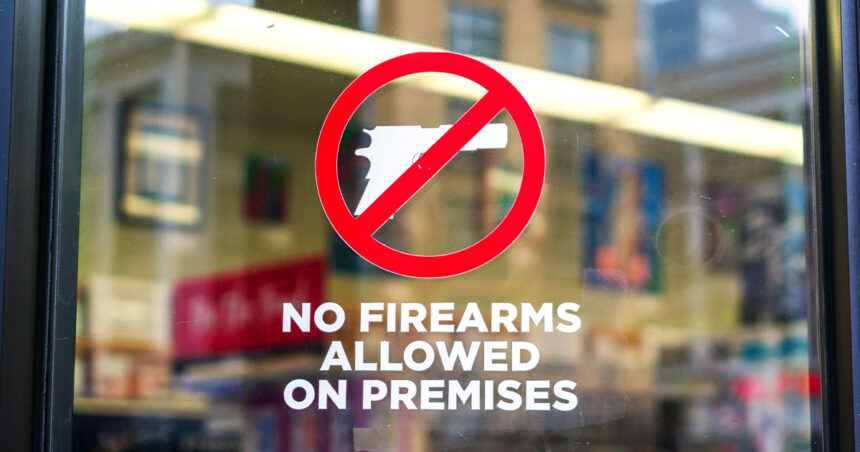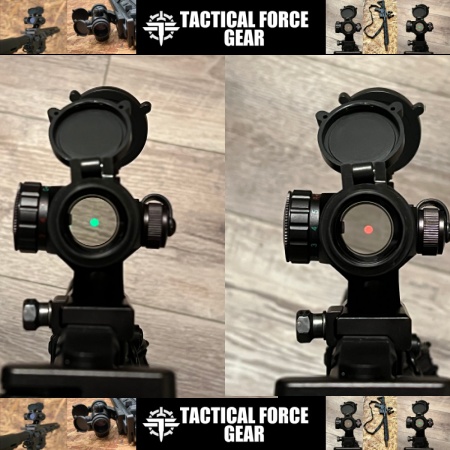Once you learn the ropes, carrying a concealed handgun isn’t too complicated, depending on where you live and how often you run around town. However, if your personal business or employment takes you to non-permissive environments and you want to retain the ability to defend yourself, it can get complicated very quickly.
Non-Permissive Environments
The term non-permissive is used as a blanket expression to describe anywhere that is not “gun friendly,” but it actually has a more nuanced meaning.
Permissive
A permissive environment is one where you can carry your gun with no concern for the consequences if someone notices it. In places where open carry is legal, you can even carry it in plain sight. Where I live, it is not at all uncommon to see someone open carrying in Walmart or at the gas station while filling their vehicle or gas cans. It’s still wise to do a good job concealing your handgun to retain the tactical advantage and not create alarm among people who are afraid of guns, but if someone notices it, it’s no big deal.
Non-Permissive
A non-permissive environment is where guns may be frowned upon, but the consequences of being caught with one are minor. There may even be a sign saying that guns are not allowed, but it does not carry the force of law behind it. If someone who cares notices you are carrying a gun, you may be asked to leave the premises, causing you some embarrassment, or to miss watching the movie or shopping. At worst, you could be banned from entering the property in the future. Non-permissive environments include places like shopping malls, stores, movie theaters, and doctor’s offices that are not part of a hospital.
Prohibited
True prohibited environments are places where being caught with a firearm can
have life-changing consequences. For example, losing your job for carrying at work in violation of company policy. There have been several stories in the news of employees being fired for possessing a gun at work, even in cases where they had to use it to protect themselves or other employees during robberies and assaults. It could also include being cited or even charged with a crime for carrying a gun at a school, the post office, or a government building. Some cities also have ordinances that make it a crime to possess a gun in a public park. Some states have laws that make it illegal to carry a gun in any restaurant that serves alcohol, whether there is a sign posted or not.
The Decision-Making Process
Every time I get ready to leave my house, I go through a decision-making process regarding how and what I will carry that day. What is the threat level, what is the environment I will be in, and what regulations, laws, or complications could affect my ability to carry legally?
Evaluating the Threat
There is a risk of being the victim of violent crime every time you leave your house. The BJS Criminal Victimization Survey found that there were 22.5 violent victimizations per 1,000 persons age 12 or older in the United States in 2023. Compare that to the odds of 1 in 1.2 million of being struck by lightning. Some environments have a higher threat profile than others, so you must evaluate it for each location you will be going to. How likely is it that you may need your firearm, and is the threat worth the possibility of problems if you are caught carrying a gun where it is not allowed?
How likely are you to get caught?
This is not a major consideration if your destination is only a non-permissive environment. It is relatively easy to conceal a handgun in a place like a shopping mall or movie cinema. With the usual amount of care, no one will ever know you have a gun unless you are forced to use it, in which case being caught carrying it will be the least significant event of the day. Even non-permissive environments vary. For example, carrying when going to the eye doctor where you will just be sitting in a chair is very different from going to a medical appointment where you will be getting undressed.
However, prohibited environments, like government buildings and schools, may incorporate active detection measures like metal detectors or trained security personnel. One day, while in the course of my work, I had to visit a privately run alternative high school for at-risk students. It was summer, and school was not in session, but knowing the law in my state covered private as well as public schools, I left my gun in a secure lockbox in the car. Good decision. When I went into the school, even though it was not in session, I had to pass through a metal detector. You should also consider the potential for an unexpected event, such as a medical emergency that leaves you helpless with a gun somewhere it is illegal to have one.
Evaluating the Consequences
Being caught with a gun in a prohibited environment can have long-term ramifications that will cause you problems for years, perhaps even for the rest of your life. These can include losing your livelihood, losing your ability to legally carry or even possess a firearm, and depending on where you live and your local prosecutor’s outlook, imprisonment. While it may be small potatoes to risk being asked to leave the property for ignoring a privately posted “No guns allowed” sign, or even risking your job to carry at work, I strongly recommend never violating the law to carry a gun where it is legally prohibited to do so.
Tactics and Techniques
Concealed carriers should always ensure their gun is concealed and that their behavior supports keeping a low profile to avoid discovery. This is even more important when carrying in a non-permissive environment.
Being the “Grey Man”
We hear the term ‘grey man’ a lot in the concealed carry world. An experience I had one day gave me an object lesson in it. We live in the country, and I usually dress like a slob around the house. I needed to run a couple of quick errands in town, so I changed clothes, including a USCCA (United States Concealed Carry Association) T-shirt. It didn’t have a picture of a gun on it or any reference to the 2nd Amendment, it just had a USCCA logo on it. As I walked into my first stop, a stranger smiled as he saw my shirt and said, “You know, I’ve been meaning to join them.” We had a brief conversation and went our separate ways. He knew immediately that I was a concealed carrier and probably figured I was armed.
No harm done since he was probably a legally armed citizen too, but it was a perfect example of not being the grey man. It didn’t matter too much that day since I wasn’t going anywhere non-permissive, but it brings home a good point. If you are going to be anywhere that might be non-permissive, avoid clothing that singles you out as a concealed carrier. No pro-Second Amendment or in-your-face patriotic shirts, no cargo pants, and nothing that might attract attention or make anyone look twice. Dress like everyone else around you; the more mundane and boring, the better.
Avoiding notice also means not acting any differently than anyone else. Do not constantly check your shirt to be sure it covers your gun or adjust your holster. If you are going to be sitting in a waiting room or at a table, be conscious of which side your gun is on. It is better to have a wall or empty space on the same side your gun is on rather than a group of people or a door. It is also better to sit in a booth at a restaurant than at a table where you can be seen from many angles.
Concealment Options
Before leaving your house, always evaluate the situation and decide what gun to take and how to carry it. Conventional wisdom is to always carry the same gun so that you don’t forget something critical in a crisis, like whether your gun has a manual safety or not. But anyone who has been carrying for a while usually has different-sized guns to suit different carry situations. For example, I have a mid-size gun for normal carry situations, a compact for less permissive environments or in hot weather, and a micro to carry in a pocket holster when I really do not want anyone to find out I am carrying a gun. The key is to ensure that all your guns have the same manual of arms and that you carry them all in the same condition. In my case, they are either striker-fired, DAO, or DA/SA, and I carry each with a round in the chamber and the safety off, for those that have a safety. That way, no matter which gun I have, all I must do is draw and pull the trigger. This allows me to match my carry gun to the environment in which I will be carrying. There are still times when I cannot carry my gun, but having options allows me to minimize those situations.
Weighing the Pros and Cons
In July of 2022, an armed citizen named Elisjsha Dicken stopped an active shooter armed with an AR15 at a shopping mall food court in Greenwood, Indiana. The shooter killed three people and wounded two before Dicken killed him with a Glock handgun. Fortunately for everyone in that food court, like the shooter, Dicken ignored the “No guns allowed” sign on the door to the mall. Dicken, who was dressed in shorts and a T-shirt, had planned well and concealed his handgun so that no one knew he had it until he was forced to use it.
Before he left the house that day, he weighed the pros and cons and made a thoughtful, informed decision to carry his gun. Other cases seldom make the news, such as when someone plans poorly and is caught carrying a gun where they should not have, with unfortunate results ranging from losing their job to being arrested. Like everything else associated with taking on the responsibility to legally carry a firearm, where and when you carry it should not be taken lightly.
Read the full article here




